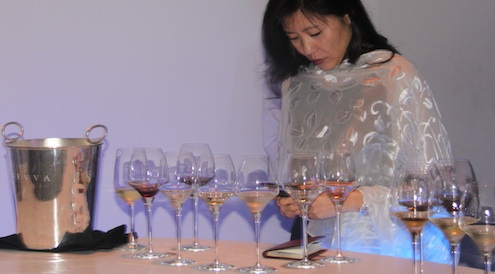
From as far back as I can remember, I wanted to be a writer. After reading numerous inspirational writing books such as Writing Down the Bones by Natalie Goldberg, Becoming a Writer by Dorothea Brande and Bird by Bird by Anne Lamont, I resolved to keep a writer’s diary. So in 1992, I spoiled myself by buying a dark brown leather notebook with refillable inserts at Hermes and a fountain pen at Mont Blanc. I was going to take writing seriously, armed with the very best ‘tools’ to encourage me. I carried the small leather notebook around with me all day and wrote down thoughts and learned to observe details and most importantly, to write everything down at the instant it occurred. I became a habitual writer and I hoped this would lead me to become a great writer one day. Sometime in early 1994, the entries in the notebook shifted from thoughts and observations to wine notes. What captured my mind and senses were the fine details and nuances of wine more than events or people. I wrote down every detail of wine tastings I attended – the place, date, the meal, along with details on the wine including the producer and wine names, vintages, origin and taste of the wines. By the end of 1994, it was clear to me that this was no longer a writer’s diary but a wine lover’s diary. I renamed my books ‘Wine Book’ and started to number them so I could keep them in order. I am now on Wine Book #58 and still taking notes the old-fashioned way. Sometime in 2007, I began to write directly onto a laptop rather than just inside my Wine Book since I realized I wanted to transcribe them onto some type of database so I could search my own notes. This would minimize the time spent transcribing my notes from my hand-written, barely legible scribbles onto a database that now contains most of my wine notes, which number around 20,000. When I first started writing wine notes, I used the five star system and rated all wines from one to five stars including half stars. From the very first tasting note I jotted down in my writer’s diary in 1992, I rated wines. I found it encouraged me to make a conclusion about the wine and I could go back to the same note and quickly see from my ratings what I thought of the wine without having to re-read the notes. After a few months, I became frustrated with the five-star system because the majority of the wines I tasted were between three and four stars. It didn’t give me enough information at a glance about what I really thought of the wine. I adopted the 20-point system since this is the point system of choice among wine show judges and in Europe. However, this rating system was not intuitive and left me aggravated and I turned to the 100-point system. Very few topics in the wine industry divide people as much as rating wines, especially the 100-point system. It is closely associated Robert Parker and Wine Spectator and now widely used by even European wine writers such as Tim Atkins. British writers are among of the most vociferous in their objections to numerical ratings, the most prominent being Hugh Johnson; meanwhile American critics and publications have been weaned an entire generation of American wine lovers on this system. As a commentator on the Asian wine market for the past 16 years, it appears that the American system has won over the Asian wine lovers – retailers and restaurants are increasingly using ratings to promote wines and many new wine lovers find the ratings easy to understand. Critics of the 100-point system make the following key points: It is really a 30 point scale since critics rarely give points below 70; publications and critics have different judging criteria so 90 points from one critic is not the same as 90 points from another critic or publication; numbers can simplify and reduce wine to a mere number and pin it down according to one taster’s judgement; ratings can give the false impression that wine can be mathematically or scientifically quantified. I can see the arguments made by the critics of the rating system, yet when I began my wine diary, I used ratings and found it very useful. The 100-point system forced me to be more precise in how I rated the quality of the wine: Is it a 95 point wine or a 91 point wine? I am also encouraged to decide, “How good is this wine?” not “How much do I like this wine?”. Wine reviews and ratings are never a precise science because good wine is a living thing – changing and evolving over time. As wine writers and reviewers, we do the best we can to take the best snapshot of the wine in a given moment in time. Thus wine notes are useful as a guideline and are an impression of one moment in a wine’s life. The better the wine, the more the wine will evolve and change, especially wines made with great precision and finesse. We know this well and reviewing wines is a constant journey of discovery, of understanding how quality expresses itself at different stages of the wine’s life and building a palate memory that can accurately convey in words all that a wine has to offer.
Reprinted with permission from the South China Morning Post









